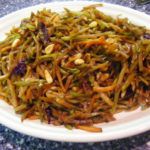7 Days of Meatless Meals the Whole Family Can Agree On
I get asked often why I chose to switch to an ovo-vegetarian diet. The ever present questions,“What do you eat?” and “Where do you get your protein?” typically come in a condescending tone paired with a scrunched face of disapproval or disgust. This took me by surprise at first, but after years of the same questions, I have come to laugh at the common misconceptions and use them as a chance to explain the morality of the decision for me, the reality of proteins available, and the array of health benefits.
After the initial seemingly startling news that my home is meatless, the second round of statements are something like, “Oh I could never do that. I love meat too much,” or “I wouldn’t even know where to start.”
I can’t argue with anyone’s choice to eat as they please, but I can help to refute some common misconceptions about a vegetarian diet lacking in both protein and the essential micro-nutrients we all need. I’ll do that below by giving 7 examples of vegetarian meals that will feed the whole family and are jam packed with the essentials for a healthy, happy, hearty meal.
Before addressing meals, though, I find it necessary to address the common misconception that a vegetarian diet is lacking in protein. A huge contributor to the idea that meat is the primary source of protein is the food pyramid. We are exposed to the food pyramid at a very young age and it continues to be pressed from grade school through high school. It is also pushed heavily by the dairy and meat industries by way of media, television, radio, etc. While watching your evening television show, try counting how many times you see a commercial talking about the food pyramid, meat, or dairy. It will surprise you.
The reality is that through these ideals, two-thirds of Americans are overweight or obese, and childhood obesity has grown exponentially in the last 30 years. Not only have the obesity rates risen, so have diseases like osteoporosis. This is due to the hydrochloric acids needed to digest meat. To neutralize these acids, our bodies use our internal source of calcium. In fact, a study published in the Medical Tribune by Michigan State (found in the book, Diet For New America), showed that female vegetarians averaged 18% bone loss while their meat-eating counterparts averaged 35% bone loss leading to osteoporosis.
What many people don’t realize is that there is protein in many of our other food groups. Foods in the legume family are a great example. Green peas contain 7.9 grams of protein per cup, taste great, and can be used in a variety of different meals. Quinoa is a grain that contains 8 grams of protein per cup. Beans are another huge protein source. Just two cups of kidney beans contain about 30 grams of protein — more than a Big Mac at McDonald’s, which has about 25 grams. Even a cup of chopped broccoli contains 8.1 grams of protein.
These are just a few examples of protein-rich foods that are healthy and taste great. Outside of those factors, our bodies digest a vegetarian/vegan diet faster than one with fat, heavy meats. With a vegetarian/vegan diet, we feel fuller faster, and overeating is less likely to occur.
The USDA nutrition database states that the average vegan male needs 63 grams of protein a day, and the average female, 53 grams per day, a quota easily met when nearly all vegetables, grains, seeds, beans, and nuts contain protein. Now that we have a better understanding of some of the key misconceptions let’s get cooking! Here are 7 meals that are protein heavy, delicious and sure to be a hit with the family.
- Broccoli Slaw Stir Fry – 24 grams of protein
Great for a busy night when there isn’t much time to prep dinner. Takes about 15 minutes to prepare and is high in protein, fiber, and vitamin C.
 Squash and Quinoa Chili – 23 grams of protein
Squash and Quinoa Chili – 23 grams of protein
Not only is it a great source of protein, but this meal provides a whopping 60% of your fiber intake as well. A base of butternut squash, quinoa, and kidney beans that can be prepared in just an hour! Great for those winter evenings in or to freeze for lunches.
 Simple Black Bean Burgers – 22 grams of protein
Simple Black Bean Burgers – 22 grams of protein
With just canned beans, eggs, and some bread crumbs, you can create a summer favorite. Add some sweet potato fries and the kids won’t be the wiser.
 Tacos – 18g and up
Tacos – 18g and up
This is a simple switch from the typical tacos you would make at home. Substitute black beans or a soy substitute (my favorite is soyrizo) for the meat.
 Sweet Potato Pizza – 22.2 grams of protein
Sweet Potato Pizza – 22.2 grams of protein
A great twist on a traditional pie that the kids can have fun helping decorate. A great way to make eating their vegetables more fun.
 Stuffed Bell Peppers – 18 grams of protein
Stuffed Bell Peppers – 18 grams of protein
A colorful addition to any dinner table. Prep for this dish takes some time, but if you are having family over and want to impress, this is one of the dishes I would go for. Always a hit with my family.
 Vegetarian Enchiladas – 34.9 grams of protein
Vegetarian Enchiladas – 34.9 grams of protein
Another example of a great, well-known dish that can be slightly tweaked using beans. Jackfruit is a great alternative as well, which makes for a fantastic vegetarian dish that everyone can enjoy.
There you have it! The recipes vary with portions, size, and desired additions as far as protein and other nutritional content, but you get the idea. There are so many possibilities! A week’s worth of meatless meals to get you started on your journey to a new lifestyle if you so choose. And the next time you discover someone you know is a vegetarian, you will have a better idea behind the health reasons and the simplicity of the choice!
Further Reading:
- For more information about micronutrients: What are Micronutrients? – IV Boost.UK
